编写一个程序来绘制基本的图形构造, 如直线, 圆, 弧, 椭圆和矩形。
#include<graphics.h>
#include<conio.h>
void main()
{
intgd=DETECT, gm;
initgraph (&gd, &gm, "c:\\tc\\bgi");
setbkcolor(GREEN);
printf("\t\t\t\n\nLINE");
line(50, 40, 190, 40);
printf("\t\t\n\n\n\nRECTANGLE");
rectangle(125, 115, 215, 165);
printf("\t\t\t\n\n\n\n\n\n\nARC");
arc(120, 200, 180, 0, 30);
printf("\t\n\n\n\nCIRCLE");
circle(120, 270, 30);
printf("\t\n\n\n\nECLIPSE");
ellipse(120, 350, 0, 360, 30, 20);
getch();
}输出量
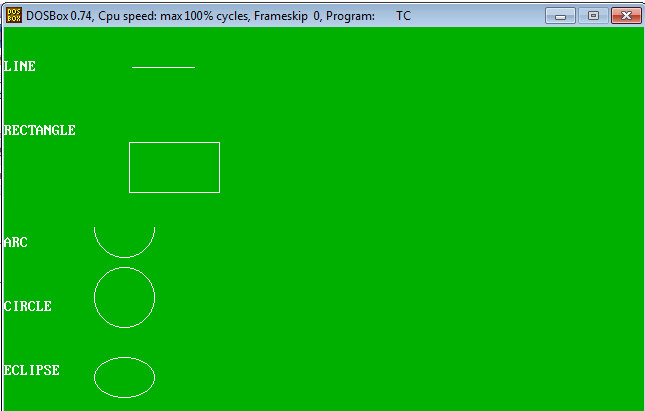
编写程序以使用填充有不同颜色和图案的递增圆形绘制动画。
#include<graphics.h>
#include<conio.h>
void main()
{
intgd=DETECT, gm, i, x, y;
initgraph(&gd, &gm, "C:\\TC\\BGI");
x=getmaxx()/3;
y=getmaxx()/3;
setbkcolor(WHITE);
setcolor(BLUE);
for(i=1;i<=8;i++)
{
setfillstyle(i, i);
delay(20);
circle(x, y, i*20);
floodfill(x-2+i*20, y, BLUE);
}
getch();
closegraph();
}输出量
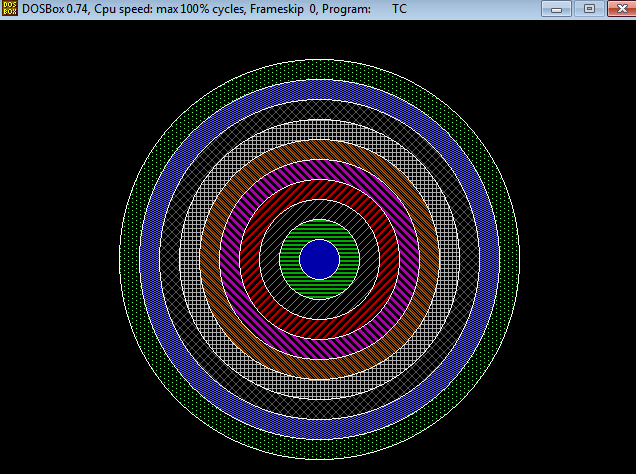
程序制作屏幕保护程序, 以显示在随机位置填充不同颜色的不同尺寸的圆圈。
#include<stdio.h>
#include<conio.h>
#include"graphics.h"
#include"stdlib.h"
void main()
{
intgd=DETECT, gm, i=0, x, xx, y, yy, r;
//Initializes the graphics system
initgraph(&gd, &gm, "c:\\tc\\bgi");
x=getmaxx();
y=getmaxy();
while(!kbhit())
{
i++;
// setfillstyle(random(i), random(30));
circle(xx=random(x), yy=random(y), random(30));
setfillstyle(random(i), random(30));
floodfill(xx, yy, getmaxcolor());
delay(200);
}
getch();
}输出量
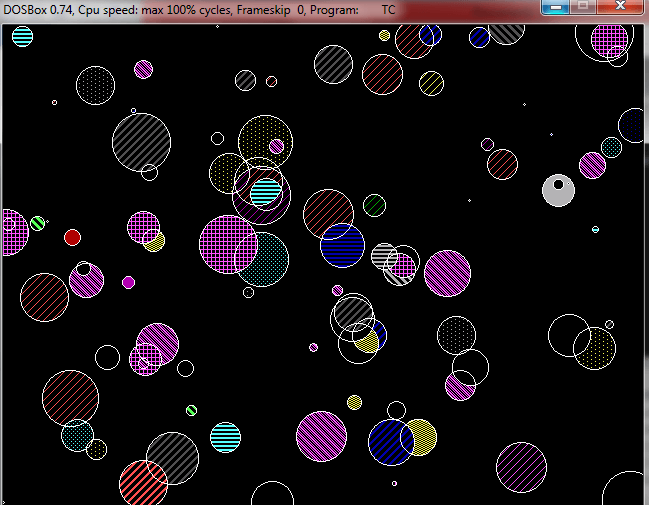
编写一个程序, 以使用内置功能制作移动彩色汽车。
#include<graphics.h>
#include<conio.h>
int main()
{
intgd=DETECT, gm, i, maxx, cy;
initgraph(&gd, &gm, "C:\\TC\\BGI");
setbkcolor(WHITE);
setcolor(RED);
maxx = getmaxx();
cy = getmaxy()/2;
for(i=0;i<maxx-140;i++)
{
cleardevice();
line(0+i, cy-20, 0+i, cy+15);
line(0+i, cy-20, 25+i, cy-20);
line(25+i, cy-20, 40+i, cy-70);
line(40+i, cy-70, 100+i, cy-70);
line(100+i, cy-70, 115+i, cy-20);
line(115+i, cy-20, 140+i, cy-20);
line(0+i, cy+15, 18+i, cy+15);
circle(28+i, cy+15, 10);
line(38+i, cy+15, 102+i, cy+15);
circle(112+i, cy+15, 10);
line(122+i, cy+15 , 140+i, cy+15);
line(140+i, cy+15, 140+i, cy-20);
rectangle(50+i, cy-62, 90+i, cy-30);
setfillstyle(1, BLUE);
floodfill(5+i, cy-15, RED);
setfillstyle(1, LIGHTBLUE);
floodfill(52+i, cy-60, RED);
delay(10);
}
getch();
closegraph();
return 0;
}输出量
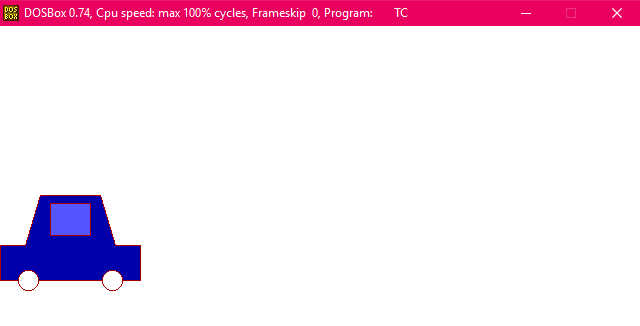
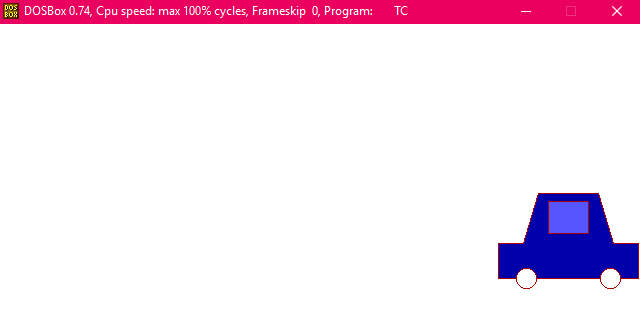
在C的控制台输出上编写程序以印地文脚本打印你的姓名。
#include<stdio.h>
#include<conio.h>
#include<graphics.h>
#include<dos.h>
void main()
{
int gd=DETECT, gm;
initgraph(&gd, &gm, "c:\\tc\\bgi");
setbkcolor(9);
line(100, 100, 370, 100);
line(120, 100, 120, 170);
arc(143, 100, 0, 180, 23);
line(165, 100, 165, 155);
arc(150, 155, 100, 0, 15);
line(180, 100, 180, 170);
circle(210, 140, 10);
line(210, 130, 250, 130);
circle(280, 140, 10);
line(280, 130, 330, 130);
line(330, 100, 330, 170);
line(345, 100, 345, 170);
ellipse(337, 100, 0, 180, 9, 18);
getch();
}输出量
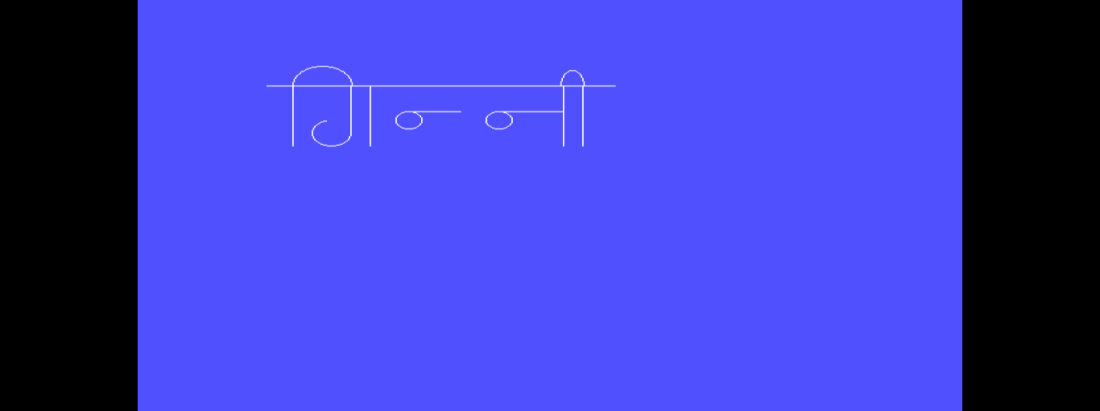
使用箭头键编写一个程序控制球。
#include<graphics.h>
#include<stdio.h>
void main()
{
intgd=DETECT, gm, x, y, r=40;
charch;
initgraph(&gd, &gm, "C:/TURBOC3/BGI");
setbkcolor(3);
x=getmaxx()/2;
y=getmaxy()/2;
setfillstyle(1, RED);
circle(x, y, r);
floodfill(x, y, getmaxcolor());
while((ch=getch())!=13)
{
switch(ch)
{
case 75: if(x>=r+1)
{
cleardevice();
circle(x-=10, y, r);
floodfill(x, y, getmaxcolor());
}
break;
case 72: if(y>=r+1)
{
cleardevice();
circle(x, y-=10, r);
floodfill(x, y, getmaxcolor());
}
break;
case 77: if(x<=(getmaxx()-r-10))
{
cleardevice();
circle(x+=10, y, r);
floodfill(x, y, getmaxcolor());
}
break;
case 80: if(y<=(getmaxy()-r-10))
{
cleardevice();
circle(x, y+=10, r);
floodfill(x, y, getmaxcolor());
}
}
}
getch();
}输出量
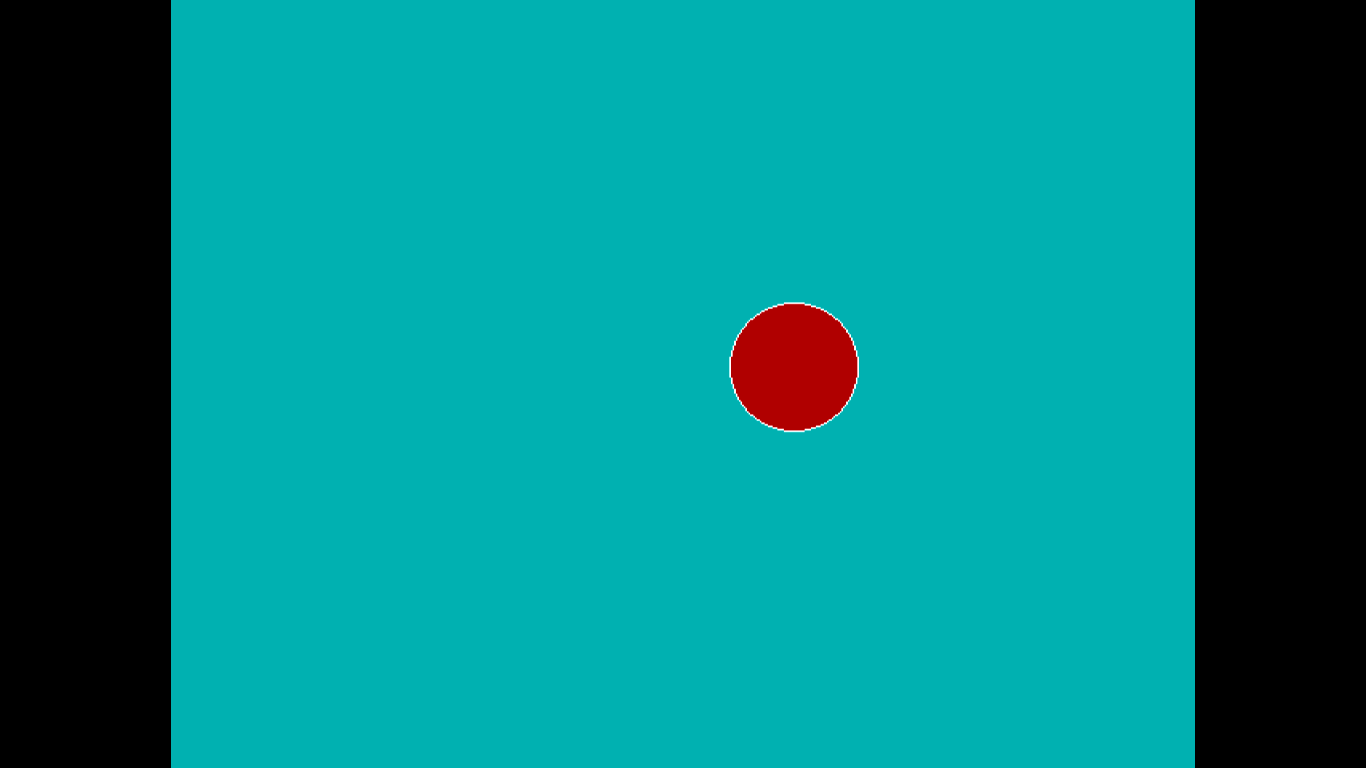
编写程序以实现数字时钟。
#include<stdio.h>
#include<conio.h>
#include<graphics.h>
#include<dos.h>
struct time t;
void display(int, int, int);
void main()
{
int i=0, gd=DETECT, gm, hr, min, sec;
clrscr();
initgraph(&gd, &gm, "c:\\turboc3\\bgi");
setcolor(GREEN);
settextstyle(4, 0, 7);
while(!kbhit())
{
gettime(&t);
hr=t.ti_hour;
min=t.ti_min;
sec=t.ti_sec;
i++;
display(100, 100, hr);
display(200, 100, min);
display(300, 100, sec);
sound(400);
delay(30);
nosound();
delay(930);
cleardevice();
}
getch();
}
void display(int x, int y, int num)
{
char str[3];
itoa(num, str, 10);
settextstyle(4, 0, 7);
outtextxy(180, 100, ":");
outtextxy(280, 100, ":");
outtextxy(x, y, str);
rectangle(90, 90, 380, 200);
rectangle(70, 70, 400, 220);
outtextxy(90, 250, "Digital Clock");
}输出量
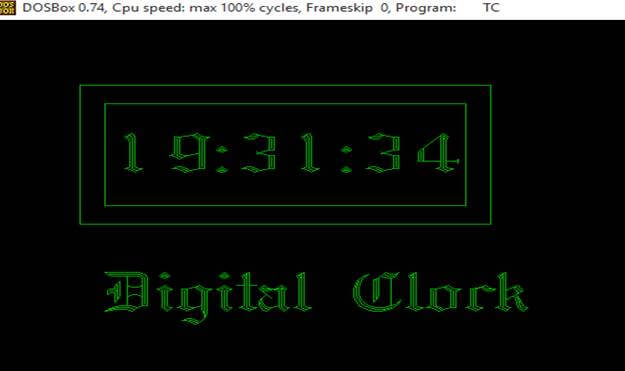
编写程序制作益智游戏。
#include<iostream.h>
#include<dos.h>
#include<conio.h>
#include<graphics.h>
#include<stdio.h>
int a[5][5];
int t[16]={0, 4, 11, 12, 7, 1, 15, 5, 13, 6, 10, 3, 2, 14, 8, 9};
int test[16]={1, 2, 3, 4, 5, 6, 7, 8, 9, 10, 11, 12, 13, 14, 15};
struct pos
{
int h, v;
}
p[4][4];
int row=4, col=4;
void game(int); //MOVEMENT
void rec(); //DRAWING RECTANGLE
void pri(); //PRINTING NUMBERS INITIALLY
int getkey(); // TO TRACE KEY PRESSED
inline void space()
{
cout<<"";
}
inline void print(int r, int c)
{
cout<<a[r][c];
}
void init(); //TO STORE CO-ORDINATES
int stop(); // STOPING CRITERION
void gopr(int, int); //TO PRINT NUMBER IN GAME
void main()
{
int gm=DETECT, gd=DETECT;
initgraph(&gm, &gd, "c:\\turboc3\\bgi");
int d, cr=1;
init();
rec();
print();
while(cr!=16)
{
d=getkey();
game(d);
cr=stop();
}
settextstyle(10, 0, 1);
outtextxy(400, 300, "You are winner!");
getch();
}
void rec()
{
setcolor(5);
for(int i=0;i<200;i+=50)
{
for(int j=0;j<240;j+=60)
rectangle(j+100, i+100, j+50, i+60);
}
}
void pri()
{
int k=1;
for(int x=0, i=6;x<4;x++, i+=3)
{
for(int y=0, j=10;y<4&&k<16;y++, j+=7, k++)
{
gotoxy(p[x][y].h, p[x][y].v);
cout<<a[x][y];
}
}
}
int getkey()
{
union REGS i, o;
while(!kbhit());
i.h.ah=0;
int86(22, &i, &o);
return(o.h.ah);
}
void init()
{
int k=1;
for(int x=0, i=6;x<4;x++, i+=3)
{
for(int y=0, j=10;y<4;y++, j+=7)
{
p[x][y].h=j;
p[x][y].v=i;
a[x][y]=t[k++];
}
}
}
void game(int s)
{
int r=row-1;
int c=col-1;
if(s==77 &&c!=0) //right
{
col--;
a[r][c]=a[r][c-1];
gopr(r, c-1);
space();
gopr(r, c);
print(r, c-1);
}
if(s==80 && r!=0) //down
{
row--;
a[r][c]=a[r-1][c];
gopr(r-1, c);
space();
gopr(r, c);
print(r-1, c);
}
if(s==75 && c!=3) //left
{
a[r][c]=a[r][c+1];
col++;
gopr(r, c+1);
space();
gopr(r, c);
print(r, c+1);
}
if(s==72 &&r!=3) //up
{
a[r][c]=a[r+1][c];
row++;
gopr(r+1, c);
space();
gopr(r, c);
print(r+1, c);
}
}
void gopr(int x, int y)
{
gotoxy(p[x][y].h, p[x][y].v);
}
int stop()
{
int k=0, d=1;
for(int x=0;x<4;x++)
{
for(int y=0;y<4;y++)
{
if(a[x][y]==test[k])
d++;
k++;
}
}
return d;
}输出量
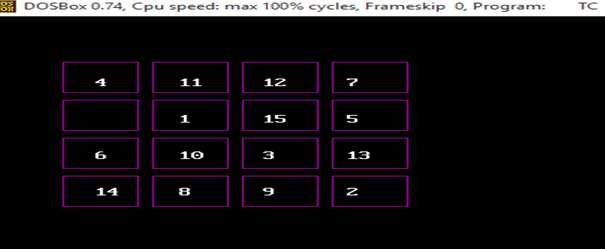
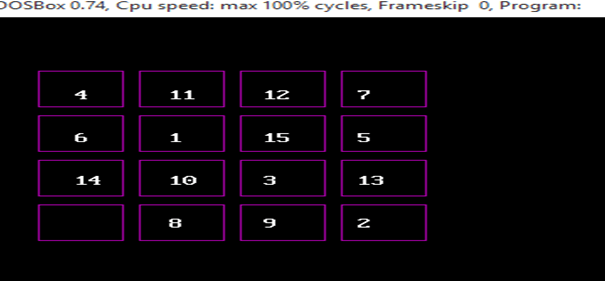
编写程序以使用正弦波形实现弹跳球。
#include<stdio.h>
#include<graphics.h>
#define HEIGHT getmaxy()
#define WIDTH getmaxx()
#define GROUND 450
#define MAXHEIGHT 420
void main()
{
int x, y=0, t=MAXHEIGHT, c=1;
int gd=DETECT, gm;
initgraph(&gd, &gm, "C:\\T urboC3\\BGI");
for(x=40;x<=getmaxx();x=x+2)
{
//Draw Ground
rectangle (0, MAXHEIGHT, getmaxx(), MAXHEIGHT+5);
floodfill (5, MAXHEIGHT+3, WHITE);
//Draw Ball
pieslice(x, y, 0, 360, 20);
//floodfill(x, y, RED);
delay(100);
if(y>MAXHEIGHT-20)
{
c=0;
t=t-40;
}
if(y<=(MAXHEIGHT-t))
{
c=1;
}
if(t>=40)
y=y+(c? 15:-15);
cleardevice();
//Exit upon keypress
if(kbhit())
break;
}
getch();
}输出量
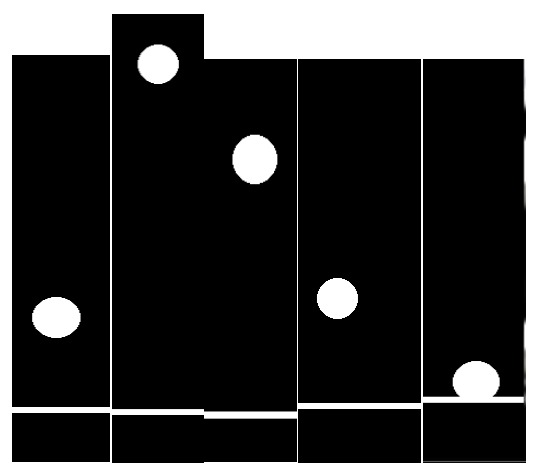
编写一个程序来实现垂直方向的弹跳球。
#include <stdio.h>
#include <conio.h>
#include <graphics.h>
#include <dos.h>
int main()
{
int gd = DETECT, gm;
int i, x, y, flag=0;
initgraph(&gd, &gm, "C:\\TC\\BGI");
x = getmaxx()/2;
y = 30;
while (!kbhit())
{
if(y >= getmaxy()-30 || y <= 30)
flag = !flag;
/* draws the gray board */
setcolor(RED);
setfillstyle(SOLID_FILL, RED);
circle(x, y, 30);
floodfill(x, y, RED);
delay(50);
cleardevice();
if(flag)
{
y = y + 5;
}
else
{
y = y - 5;
}
}
getch();
closegraph();
return 0;
}输出量
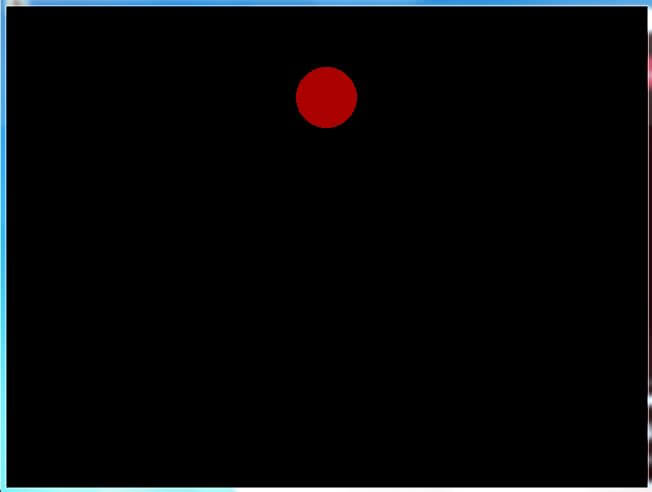
使用复合转换编写一个平移, 旋转和缩放的程序。
#include<stdio.h>
#include<conio.h>
#include<graphics.h>
#include<math.h>
int x1, y1, x2, y2, x3, y3, a, b;
void draw();
void rotate();
int main(void)
{
int gd=DETECT, gm;
initgraph(&gd, &gm, "C:\\TC\\BGI");
printf("Enter first co-ordinate value for triangle:");
scanf("%d%d", &x1, &y1);
printf("Enter second co-ordinatevalues for triangle:");
scanf("%d%d", &x2, &y2);
printf("Enter third co-ordinate valuesfor triangle:");
scanf("%d%d", &x3, &y3);
draw();
getch();
rotate();
getch();
return 0;
}
void draw()
{
line(x1, y1, x2, y2);
line(x2, y2, x3, y3);
line(x3, y3, x1, y1);
}
void rotate()
{
int a1, a2, a3, b1, b2, b3;
float angle;
printf("Enter the rotation angle co-ordinates:");
scanf("%f", &angle);
cleardevice();
angle=(angle*3.14)/180;
a1=a+(x1-a)*cos(angle)-(y1-b)*sin(angle);
b1=b+(x1-a)*sin(angle)+(y2-b)*cos(angle);
a2=a+(x2-a)*cos(angle)-(y1-b)*sin(angle);
b2=b+(x2-a)*sin(angle)+(y2-b)*cos(angle);
a3=a+(x3-a)*cos(angle)-(y1-b)*sin(angle);
b3=b+(x3-a)*sin(angle)+(y2-b)*cos(angle);
printf("ROTATION");
printf("\n Changed coordinates\n");
printf("%d %d\n%d %d\n%d %d", a1, b1, a2, b2, a3, b3);
line(a1, b1, a2, b2);
line(a2, b2, a3, b3);
line(a3, b3, a1, b1);
}输出量
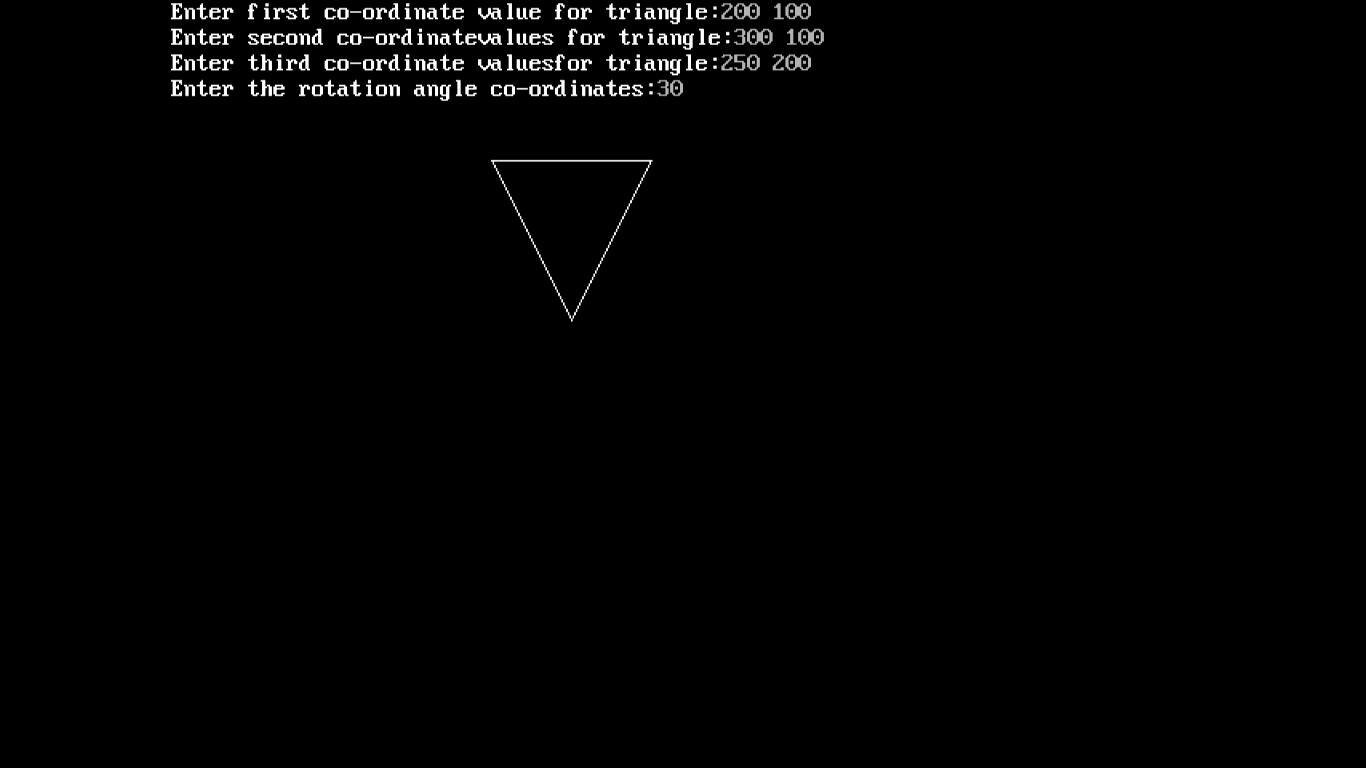
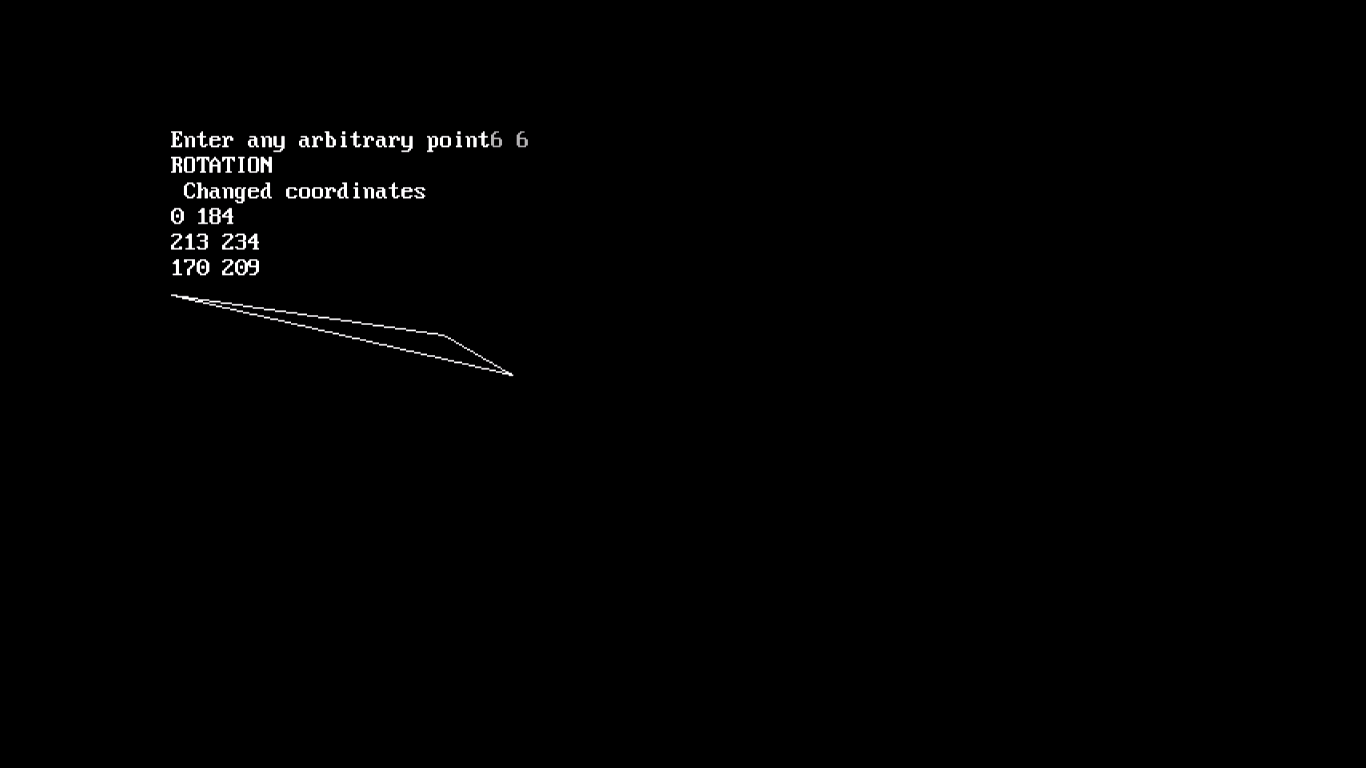
编写程序以使用中点实现方法绘制圆。
#include<stdio.h>
#include<graphics.h>
void drawcircle(int x0, int y0, int radius)
{
int x = radius;
int y = 0;
int err = 0;
while (x >= y)
{
putpixel(x0 + x, y0 + y, 7);
putpixel(x0 + y, y0 + x, 7);
putpixel(x0 - y, y0 + x, 7);
putpixel(x0 - x, y0 + y, 7);
putpixel(x0 - x, y0 - y, 7);
putpixel(x0 - y, y0 - x, 7);
putpixel(x0 + y, y0 - x, 7);
putpixel(x0 + x, y0 - y, 7);
if (err <= 0)
{
y += 1;
err += 2*y + 1;
}
if (err > 0)
{
x -= 1;
err -= 2*x + 1;
}
}
}
void main()
{
int gdriver=DETECT, gmode, error, x, y, r;
initgraph(&gdriver, &gmode, "c:\\turboc3\\bgi");
printf("Enter radius of circle: ");
scanf("%d", &r);
printf("Enter co-ordinates of center(x and y): ");
scanf("%d%d", &x, &y);
drawcircle(x, y, r);
getch();
}输出量
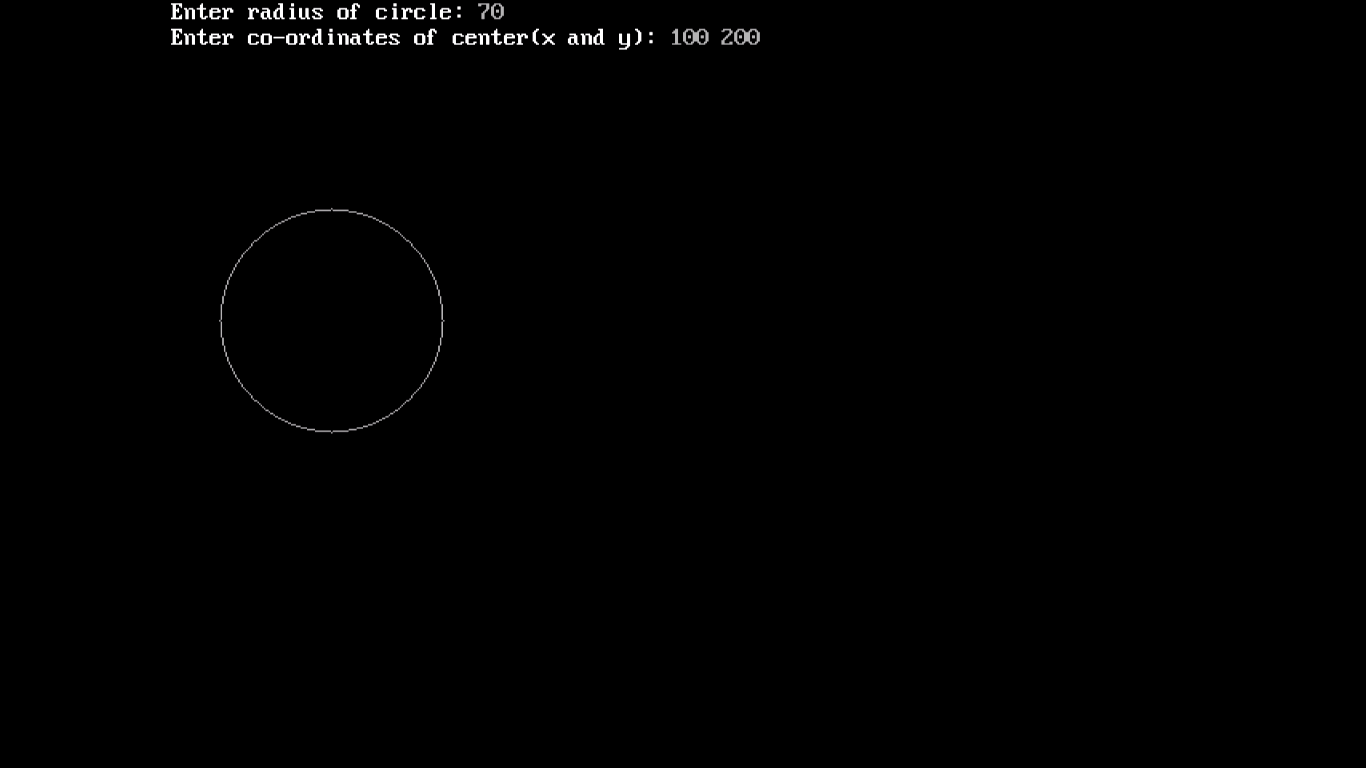
编写程序以绘制贝塞尔曲线。
#include <stdio.h>
#include <stdlib.h>
#include <graphics.h>
#include <math.h>
void bezier (int x[4], int y[4])
{
int gd = DETECT, gm;
int i;
double t;
initgraph (&gd, &gm, "C:\\tc\\bgi");
for (t = 0.0; t < 1.0; t += 0.0005)
{
double xt = pow (1-t, 3) * x[0] + 3 * t * pow (1-t, 2) * x[1] +
3 * pow (t, 2) * (1-t) * x[2] + pow (t, 3) * x[3];
double yt = pow (1-t, 3) * y[0] + 3 * t * pow (1-t, 2) * y[1] +
3 * pow (t, 2) * (1-t) * y[2] + pow (t, 3) * y[3];
putpixel (xt, yt, WHITE);
}
for (i=0; i<4; i++)
putpixel (x[i], y[i], YELLOW);
getch();
closegraph();
return;
}
void main()
{
int x[4], y[4];
int i;
printf ("Enter the x- and y-coordinates of the four control points.\n");
for (i=0; i<4; i++)
scanf ("%d%d", &x[i], &y[i]);
bezier (x, y);
}输出量
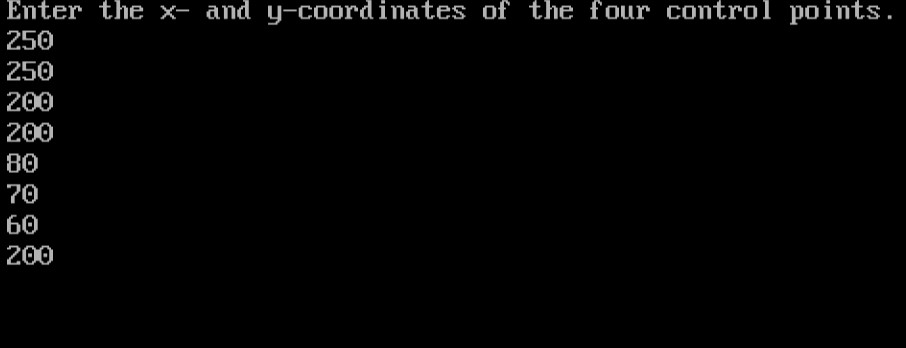
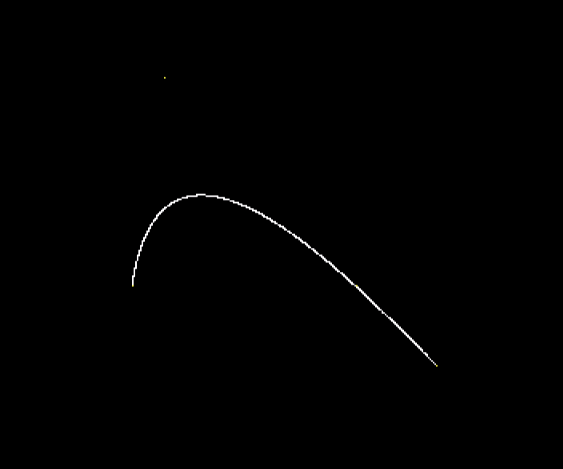
程序围绕其中点旋转矩形
#include<iostream.h>
#include <stdio.h>
#include<conio.h>
#include<graphics.h>
#include<stdlib.h>
#define pi 3.14
class arc
{
float x[10], y[10], theta, h1, k1, r[0][10], ang;
float p[10][10], p1[10][10], x1[10], y1[10], xm, yx;
int i, k, j, n;
public:
void get();
void cal();
void map();
void graph();
void plot();
void plot1();
};
void arc::get()
{
cout "<<"\n ENTER ANGLE OF ROTATION ";
cin>>ang;
n = 4;
cout<<"\n ENTER";
for (i=0; i<n; i++)
{
cout<<"\n x["<i<<"] and y["<<i<<"]";
cin>>x[i]>>y[i];
}
h1=x [0] + (([1]-x[0])/2);
k1=y[0]+(([3]-y[0])/2);
cout<<"\n MIDPOINT OF RECTANGLE IS--"<<h1<<"\t"<<k1;
theta=(ang*pi)/180?;
r[0][0]=cos (theta);
r[0][1]= -sin?(theta);
r[0][2]=(-h1*cos(theta))+(k1*sin(theta)+h1;
r[1][0]=sin (theta);
r [1][1]=cos (theta);
r [1][2]=(-h1*sin(theta))+(-k1*cos(theta)+k1;
r[2][0]=0;
r[2][1]=0;
r[2][2]=1;
}
void arc ::cal()
{
for(i=0;i<n;i++)
{
p[0][i]=x[i];
p[1][i]=y[i];
p[2][i]=1;
}
for(i=0;i<3;i++)
{
for(j=0;j<n;j++)
{
p1[i][j]=0;
for (k=0;k<3;k++)
{
p1[i][j]+=r[i][k]*p[k][j];
}
}
}
for(i=0;i<n;i++)
{
x1[i]=p1[0][i];
y1[i]=p[1][i];
}
}
void arc::map()
{
int gd=DETECT, gm;
initgraph (&gd, &gm, "");
int errorcode = graphresult();
/*an error occurred */
if (errorcode!=grOK)
{
printf("Graphics error: %s \n", grapherrormsg (errorcode));
printf("Press and key to halt: ");
getch();
exit(1); /* terminate with an error code */
}
}
void arc::graph()
{
xm=getmaxx()/2;
ym=getmaxy()/2;
line (xm, 0, xm, 2 * ym);
line (0, ym, 2 * xm, ym);
}
void arc :: plot 1()
{
for (i=0;i<n-1;i++)
{
circle (x1[i]+xm, (-y1[i]+ym), 2);
line (x1[i]+xm, (-y1[i]+ym), x[i+1] xm, (-y1[0]+ym));
}
line (x1[n-1] +xm, (-y1[n-1]+ym), x1[0]+xm, (-y1[0]+ym));
getch();
}
void arc :: plot ()
{
for (i=0;i<n-1;i++)
{
circle (x[i]+xm, (-y[i]+ym), 2);
line (x[i]+xm, (-y[i]+ym), x[i+1] xm, (-y[i+1]+ym));
}
circle (x[n-1]+xm, (-y[n-1]+ym), 2);
line (x[n-1]+xm, (-y[n-1]+ym), x[0]+xm, (-y[0]+ym));
getch();
}
void main ()
{
class arc a;
clrscr();
a.map();
a.graph();
a.get();
a.cal();
a.plot();
a.plot1();
getch();
}输出量
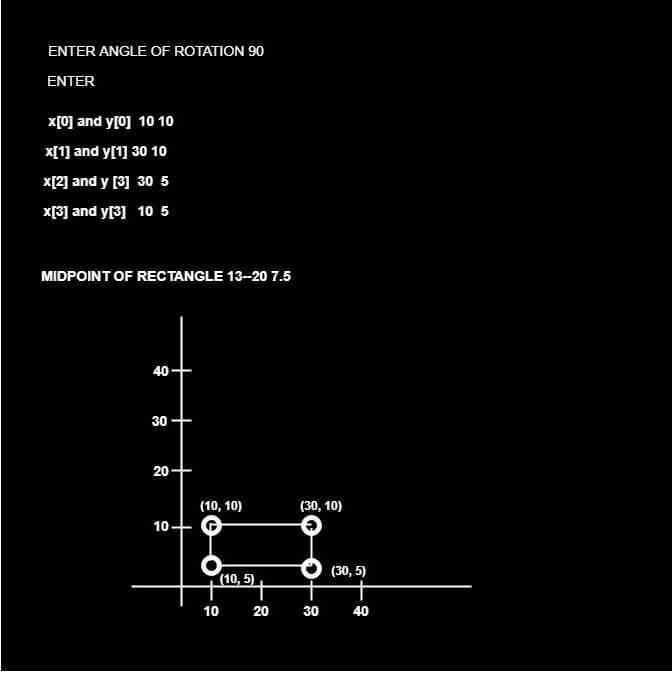
程序使用Liang Barsky方法剪切线
#include<iostream.h>
#include <stdio.h>
#include<conio.h>
#include<graphics.h>
#include<process.h>
class liang
{
float x1, x2, y1, y2, u1, u2, dx, dy, xm, ym;
float xmin, ymin, xmax, ymax, p[4], q[4], r[5], r[5];
int gd, gm, test, s, k;
public:
void clipliang();
void get();
void map();
void graph();
};
void liang :: map()
{
gd=DETECT;
initgraph (&gd, &gm, "");
int errorcode = graphresult();
/*an error occurred */
if (errorcode!=grOK)
{
printf("Graphics error: %s \n", grapherrormsg (errorcode));
printf("Press and key to halt: ");
getch();
exit(1); /* terminate with an error code */
}
}
void liang::graph()
{
xm=getmaxx()/2;
ym=getmaxy()/2;
line (xm, 0, xm, 2 * ym);
line (0, ym, 2 * xm, ym);
}
void liang :: get()
{
cout<<"\n ENTER WINDOW COORDINATES xwmin, ywmin, xwmax, ywmax";
cin>>xmin>>ymin>>xmax>>ymax>>;
rectangle (xmin+xm, -ymin+ym, xmax+xm, -ymax+ym);
// rectangle (320+xwmin, 240-ywmax, 320+xwmax, 240-ywmin);
cout<<"\n ENTER END POINTS OF LINE (x1, y1)(x2, y2) ";
cin>>x1>>y1>>x2>>y2;
line (x1+xm, -y1+ym, x2+xm, -y2+ym);
getch();
}
// line (x1, y1, x2, y2);
void liang :: clipliang()
{
float x=0, y=1;
dx=x2-x1;
dy=y2-y1;
p[0]=-dx;
p[1]=dx;
p[2]=-dy;
p[3]=dy;
q[0]=x1-xmin;
q[1]=xmax-x1;
q[2]=y1-ymin;
q[3]=ymax-y1;
for (k=0;k<4;k++)
{
if (p[k]==0&&q[k]<0)
{
cout<<"\n OUTSIDE";
getch();
exit(0);
}
if (p[k]<0)
{
r[k]=q[k]/p[k];
if (r1[k]<y)
y=r1[k];
u2=y;
}
}
if (u1>u2)
{
cout<<"\n COMPLETE OUTSIDE WINDOW";
getch();
exit(0);
}
void main ()
{
liang1;
clrscr();
l.map();
l.graph();
l.get();
l.clipliang();
getch();
}输出量
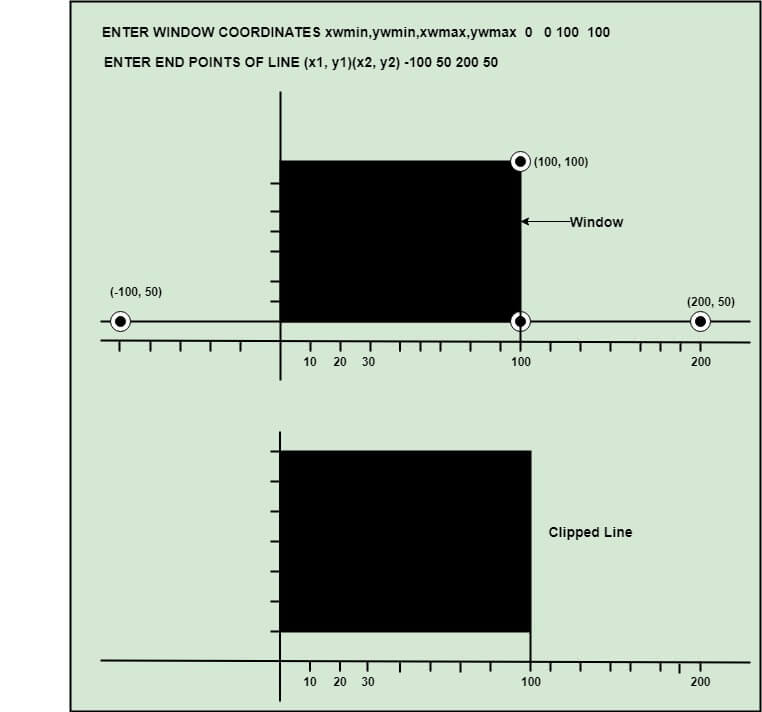
用于实现3维标准透视投影的程序。
#include<iostream.h>
#include<conio.h>
#include<graphics.h>
#include<math.h>
#include<stdio.h>
#include<stdlib.h>
#define pi 3.14
class per
{
float x[10], y[10], z [10], d;
float x1 [10], y1[10], xm, ym, z1 [10];
int i, k, j, n;
public:
void get();
void perpro();
void map();
void graph();
void plot1();
}
void per::get()
{
cout<< "\n ENTER OF VERTICES";
cin>>n;
cout<<"\n ENTER";
for (i=0;i<n;i++)
{
cout<<"\n x["?i<<"], y["<<i<<"] and z ["<<i<<"]";
cin>>x[i]>>y[i]>>z[i];
}
cout<<"\n ENTER WIDTH FOR Z-AXIS-d";
cin>>d;
}
void per:: perpro()
{
for(i=0;i<n;i++)
{
x1[i]=(d*x[i])/(z[i]+d);
y1[i]=(d*y[i])/(z[i]+d);
z1[i]=0;
}
cout<< "\n ENTER PROJECTION, VERTICES OF POLYGON ARE--";
for(i=0;i<n;i++)
{
cout<<"x?["<<i<<"]="<<x1[i]<< "\t";
cout<<"y?["<<i<<"]="<<y1[i]<< "\t";
cout<<"z?["<<i<<"]="<<z1[i]<< "\t";
cout<<"\n";
}
}
void per :: map()
{
int gd=DETECT;
initgraph (&gd, &gm, "");
int errorcode = graphresult();
/*an error occurred */
if (errorcode!=grOK)
{
printf("Graphics error: %s \n", grapherrormsg (errorcode));
printf("Press and key to halt: ");
getch();
exit(1); /* terminate with an error code */
}
}
void per::graph()
{
xm= get maxx()/2;
ym=get maxy()/2
line (xm, 0, xm, 2 * ym);
line (0, ym, 2 * xm, ym);
}
void per::plot1()
{
for(i=0;i<n-1;i++)
{
line(x1[i]*100+xm, (-y1[i]*100+ym), x1[i+1]*100+xm, (-y1[i+1]*100+ym));
}
line(x1[n-1]*100+xm, (-y1[n-1]*100+ym), x1[0]*100+xm, (-y1[0]*100+ym));
getch();
}
void main()
{
class per a;
clrscr();
a.map();
a.graph();
a.get();
a.perpro();
a.graph();
a.plot1();
getch();
}输出量
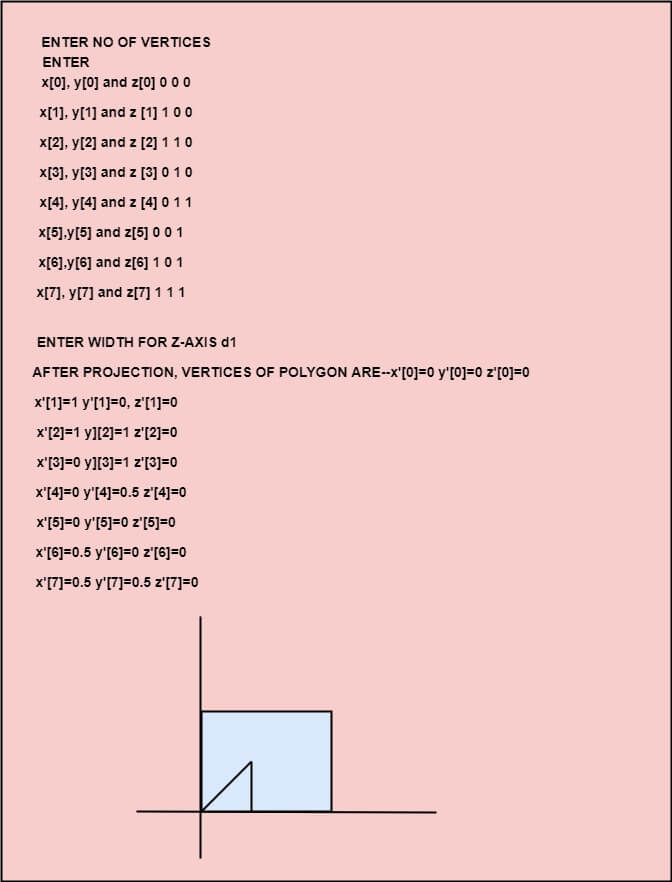
实现3维平行投影的程序。
#include<iostream.h>
#include<conio.h>
#include<graphics.h>
#include<math.h>
#include<stdio.h>
#include<stdlib.h>
#define pi 3.14
class per
{
float x[10], y[10], z [10], d, m[10], q1[10], r1[10], m1[10];
float x1 [10], y1[10], xm, ym, z1 [10], cav[4] [4], p[10] [10];
float p1[10] [10];
float a, b, c, ang, theta, f;
int i, k, j, n;
public:
void get();
void par_v();
void par_vnr0();
void map();
void graph();
void project(float m[], float q[], float r[]);
};
void per:: perproject(float m[], float q[], float r[])
{
cout<<"\n ENTER WIDTH FOR Z-AXIS d";
cin>>d;
cout<< "\n AFTER PROJECTION, VERTICES OF POLYGON ARE--";
for(i=0;i<n;i++)
{
cout<<"x?["<<i<<"]="<<x1[i]<< "\t";
cout<<"y?["<<i<<"]="<<y1[i]<< "\t";
cout<<"z?["<<i<<"]="<<z1[i]<< "\t";
cout<<"\n";
}
getch();
clearviewport();
graph();
for(i=0;i<n-1;i++)
{
line(m[i]*100+xm, (-q[i]*100+ym), m[i+1]*100+xm, (-n1[i+1]*100+ym));
}
line(m[n-1]*100+xm, (-q[n-1]*100+ym), m[0]*100+xm, (-q[0]*100+ym));
getch();
}
void per::get()
{
cout<< "\n ENTER OF VERTICES";
cin>>n;
cout<<"\n ENTER";
for (i=0;i<n;i++)
{
cout<<"\n x["?i<<"], y["<<i<<"] and z ["<<i<<"]";
cin>>x[i]>>y[i]>>z[i];
}
cout<<"\n ENTER WIDTH FOR Z-AXIS-d";
cin>>d;
int ch=100;
do
{
cout<< "\n 1->orthographic projection";
cout<<"\n 2->oblique projection";
cout<<"\n 0-> exit";
cout<<"\n enter ch";
cin>>ch;
switch (ch)
{
case1:
int ch1=100;
do
{
cout<<"\n 1->for xy viewplane";
cout<<"\n 2->for yz viewplane";
cout"\n 3->for zx viewplane";
cout<<"\n 0->exit";
cout<<"\n enter ch1";
cin>>ch1;
switch(ch1)
{
case1:
x1[i]=x[i];
y1[i]=y[i];
z1[i]=0;
project(x1, y1, z1);
break;
case2:
x1[i]=0;
y1[i]=0;
z1[i]=z[i];
project(x1, y1, z1);
break;
case3:
x1[i]=x[i];
y1[i]=0;
z1[i]=z[i];
project(x1, y1, z1);
break;
}
}
while (ch!=0)
break;
case2:
ch1=100;
do
{
cout<<"\n 1->on xy plane";
cout<<"\n 2->cavalier";
cout<<"\n 0->exit";
cout<<"\n enter ch1";
cin>>ch1;
switch(ch1)
{
case1:
par_v();
break;
case2:
par_vnr0();
break();
}
while(ch!=0);
break;
}
while(ch!=0)
}
void per::par_v()
{
cout<<"\n enter v (a, b, c) " ;
cin>>a>>b>>c;
for(i=0; i<n;i++)
{
x1[i]=x[i]-((a*z[i]/c);
y1[i]=y[i]-((b*z[i]/c);
project(x1, y1, z1);
}
}
void per::par_vnr0()
{
cout<<"\n enter f";
cin>>f;
cout<<"\n enter angle";
cin>>angle;
theta= ((pi/180)* ang);
for(i=0;i<4;i++)
{
for(j=0;j<4;j++)
{
if(i==j)
cav[i] [j]=1;
else
cav[i] [j]=0;
}
}
cav[0] [2]=f*cos(theta);
cav[1][2]=f*sin (theta);
cav[2][2]=0;
for(i=0;i<n;i++)
{
p[0][i]=x[i];
p[1][i]=y[i];
p[2][i]=z[i];
p[3][i]=1;
}
for(i=0;i<4;i++)
{
for(j=0;j<n;j++)
{
p1[i][j]=0;
for(k=0;k<4;k++)
{
p1[i][j]+=cav[i][k]*p[k][j];
}
}
}
for(i=0;i<n;i++)
{
x1[i]=p1[0][i];
y1[i]=p1[1][i];
z1[i]=p1[i];
}
project(x1, y1, z1);
}
void per :: map()
{
int gd=DETECT;
initgraph (&gd, &gm, "");
int errorcode = graphresult();
/*an error occurred */
if (errorcode!=grOK)
{
printf("Graphics error: %s \n", grapherrormsg (errorcode));
printf("Press and key to halt: ");
getch();
exit(1); /* terminate with an error code */
}
}
void per::graph()
{
xm= get maxx()/2;
ym=get maxy()/2
line (xm, 0, xm, 2 * ym);
line (0, ym, 2 * xm, ym);
}
void main()
{
class per a;
clrscr();
a.map();
a.get();
getch();
}输出量
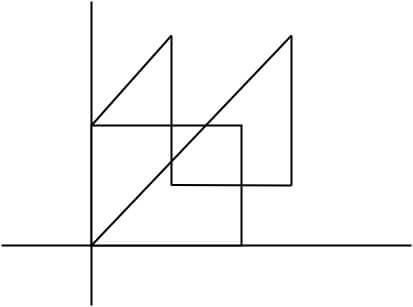
绘制正弦, 余弦和正切曲线的程序
#include<iostream.h>
#include<conio.h>
#include<graphics.h>
#include<math.h>
#include<stdio.h>
#include<stdlib.h>
#define pi 3.14
class arc
{
float x, y, a, xm, ym;
int i, ch;
public:
void get();
void map();
void sine();
void cosine();
void tangent();
};
void arc::get()
{
cout<<"\n ENTER THE MAXIMUM VALUE FOR Y";
cin>>y;
cout<<"\n MENU IS---------";
cout<<"\n 1-> SINE CURVE";
cout<<"\n 2->COSINE CURVE";
cout<<"\n 3-> TANGENT CURVE";
cout<<"\n 4-> EXIT";
cout<<"\n ENTER YOUR CHOICE";
cin>>ch;
switch(ch)
{
case1:
sine();
break();
case2:
cosine();
case3:
tangent();
case4:
exit(0);
}
}
void arc::sine()
{
cleardevice();
xm=getmaxx()/2;
ym=getmaxy()/2;
line(xm, 0, xm, 2*ym);
line(0, ym, 2 *xm, ym);
outtextxy(0, ym, "X-AXIS");
outtextxy(xm, 0, "Y-AXIS");
for(x=-300;x<=300;x=x+0.5)
{
y=a*sin((pi*x)/180);
putpixel(x+(320), -y+240, RED);
}
}
void arc::cosine()
{
cleardevice();
xm=getmaxx()/2;
ym=getmaxy()/2;
line(xm, 0, xm, 2*ym);
line(0, ym, 2 *xm, ym);
outtextxy(0, ym, "X-AXIS");
outtextxy(xm, 0, "Y-AXIS");
for(x=-300;x<=300;x=x+0.5)
{
y=a*cos((pi*x)/180);
putpixel(x+(320), -y+240, RED);
}
}
void arc :: map()
{
int gd=DETECT, gm;
initgraph (&gd, &gm, "");
int errorcode = graphresult();
/*an error occurred */
if (errorcode!=grOK)
{
printf("Graphics error: %s \n", grapherrormsg (errorcode));
printf("Press and key to halt: ");
getch();
exit(1); /* terminate with an error code */
}
}
void main()
{
class arc a;
clrscr();
a.map();
a.get();
getch();
}输出量
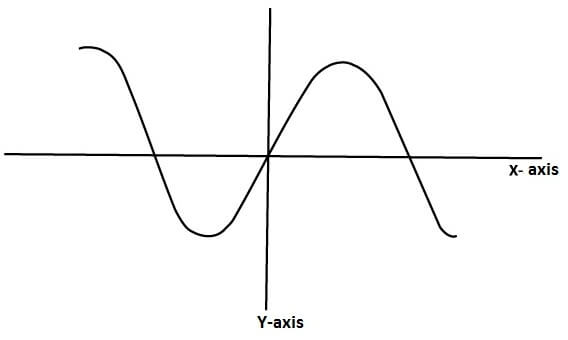
 srcmini
srcmini
评论前必须登录!
注册